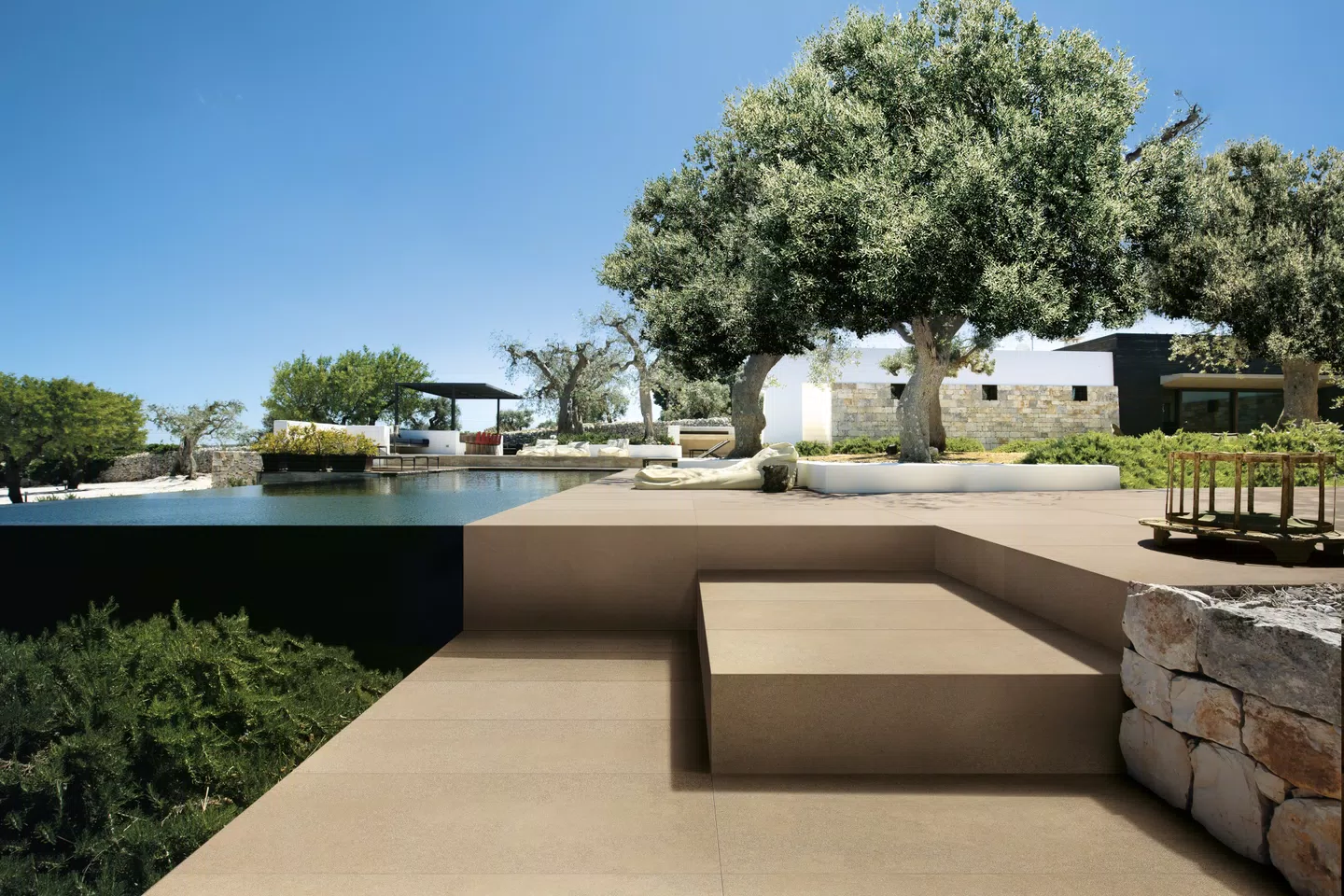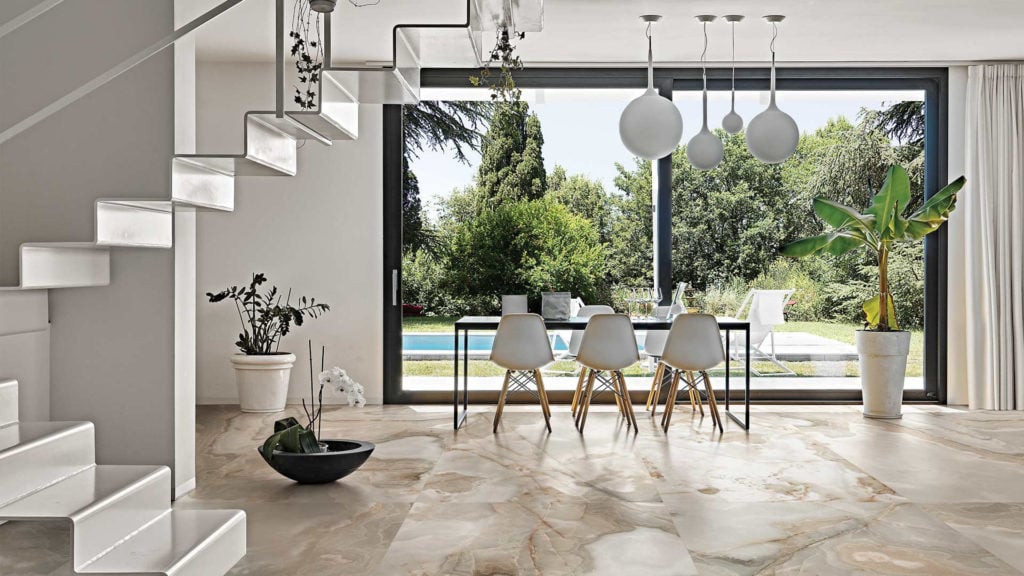Sustainable building: business models and positive choices
The sustainable building market is a growing global trend. Supported by Government policies and business models increasingly inspired by the circular economy. The ceramics industry has successfully made a place for itself within this global context by investing in sustainable research and development.
The green building market is growing sharply, as revealed by a recent American Research & Markets survey published in Environmental Leader journal: in fact, worldwide it is predicted to reach a value of 187.4 billion dollars by 2027, with an annual growth rate of 8.6%.
This scenario is also confirmed by the World Green Building Council, according to which infrastructures and buildings will aim to reduce their carbon emissions by 40% by 2030 and by 100% by 2050. And, therefore, prefabricated homes complete with green certifications such as LEED (Leadership in Energy and Environmental Design), safer in terms of earthquake resistance and with lower environmental impact, and the use of ecological materials and systems with automated, integrated management (smart buildings), will open the way to an era of connectivity that will facilitate data management in the construction sector.
In Europe, buildings and the construction sector are responsible for 36% of annual CO2 emissions, 40% of energy consumption, 50% of raw material extraction and 21% of drinking water use, and the industry generates 18 million jobs.
As well as being a powerful driver of the global economy, the construction sector is also crucial for the achievement of many of the United Nations sustainable development goals, the center of attention also of European economic policy in coming years.
Business looks to circular economy models
Naturally, the circular economy cannot change the world without the support of countries and nations, political choices and general rules. In 2015 the Finnish Government set out to make the country a leader in the global circular economy and issued a roadmap for the implementation of this ambitious plan. Canada is another country which is pushing hard towards a circular economy model. Legislators in Ontario agreed a plan intended to ensure a waste-free future in February 2017. The Netherlands have set themselves the target of adopting a circular system by 2050. This project focuses on five crucial sectors: biomass and food, plastics, manufacturing, construction and consumer goods.
The eleventh GreenItaly Report issued by Fondazione Symbola and Unioncamere recently measured the strength of the country’s green economy. The Report confirms that over 432 thousand Italian industrial and services companies with employees have invested in green products and technology in the last 5 years (2015-2019). This value shows an increase over the previous five years, when the number was 345 thousand (24% of the total). In manufacturing, the figure is more than one in three (35.8%).
Energy efficiency and renewable sources account for the lion’s share of these investments, together with cuts in water consumption and waste production, followed by reduction of pollutants and increases in the use of secondary raw materials.
The survey clearly shows that the combination of green policies and digital technologies reinforces companies’ ability to compete. In 2020, companies oriented towards an industry 4.0 model which invested in environment-friendly projects saw their turnover rise in 20% of cases, a figure higher than the total of 16% for green companies and more than twice the 9% of non-green businesses.
Life cycle is crucial when choosing materials
Products’ life cycle has now become an essential factor when defining them as “sustainable”: just being made from natural or recycled materials does not make a product “environment-friendly”. Knowledge of impacts has now reached levels in which everyone will understand that a product’s life cycle starts from the moment when the raw materials are obtained – or even before that, when the decision where and how to obtain them is made – and does not end until the product has been completely decommissioned or its material has been converted into something else through recycling value chains.
However, rather than the individual product, a life cycle assessment should evaluate the whole building system, considering its energy consumption:
- for the production of construction materials and components;
- for transportation of materials from the production facilities to the building site;
- for construction as such;
- during operation, for heating, hot water production, etc.:
- building demolition process;
- positive input from the recycling of materials and components.
Therefore, when choosing the materials and components for a project, every single element’s interrelations with the building’s system must be identified and its role in the overall energy balance must be assessed.
Choosing ceramics forms part of a correct design approach, which considers the work’s entire life cycle, the only possible vision for a responsible attitude to the future of the spaces and territories where we live.

Sensi Collection
find out more
Ceramics, a low-impact supply chain
Ceramic tiles and slabs have a lower environmental impact than other finishing materials due to the intensive technological, plant design and production innovation undertaken by this industry in Italy.
The industry is also able to recycle most waste produced during the production process, which requires considerable amounts of energy. This consumption has been sharply reduced compared to past years.
Moving on to the next phase in the tile’s life cycle, its final installation, the materials used for installation and grouting are of negligible importance from the toxicological point of view, and the same applies to the demolition of tiling, the rubble from which can be placed in the environment without any particular risks.
Tiles’ technical performances and outstanding durability are equally important.
There are thus many reasons for confirming that ceramics are one of the surface covering materials best able to respond to today’s performance demands.

Earthtech Collection
find out more
Responsible management by the manufacturer
We have said that the entire ceramics industry has been working for many years to reduce its use of energy and natural resources. Florim, for example, has always been strongly committed to reducing the environmental impact of its production operations, documenting this in a sustainability report published for the last sixteen years, which describes impressive strategies and investments, as well as the work of its research laboratories and the efforts of its employees. From the new photovoltaic plant to the new production waste recovery processes, the company has managed to keep its use of resources down in spite of the growth in its Italian production capacity.
Unlike that of other natural materials such as stone or timber, the production of Made in Florim porcelain stoneware has no significant impacts on territorial biodiversity.
Great care is taken over the selection of suppliers of the raw materials used in tile body mixes, who are required to cooperate with the company in fully protecting ecosystems and biodiversity. The company also has software for the management of raw material origin data (quarry location, distance from the factory, technical datasheets, etc.).
Florim, sustainable, certified products
Due to their nature, all the Florim Group’s products are guaranteed free from pollutant emissions, do not accumulate electrostatic charges, are frost-proof and completely inert and are undamaged by contact with flames. 100% of greenware waste from the production process and 100% of wastewater are recycled in every Florim plant. The many product certifications held (Green Building Council, Ecolabel, Greenguard, EPD, NSF, HPD – Health Product Declaration) confirm the absolute, proven sustainability of the brand’s products.
The Fiorano Modenese brand’s green figures
- 64.000 m2 of photovoltaic panels
- 2 cogeneration plants
- 12452 of CO2 not emitted
- 96.5 GW of electricity self-produced
- 100% recycling of wastewater
- 100% recycling of industrial waste
- Up to 100% of total electricity consumed is self-produced
- Product and process environmental certifications (Green Building Council, Ecolabel, Greenguard, EPD)
- HPD – Health Product Declaration
- ISO 14001, 50001, 9001 and 45001 certifications and AEO customs certification
Florim is also a Benefit Corporation. Click here to learn more.





